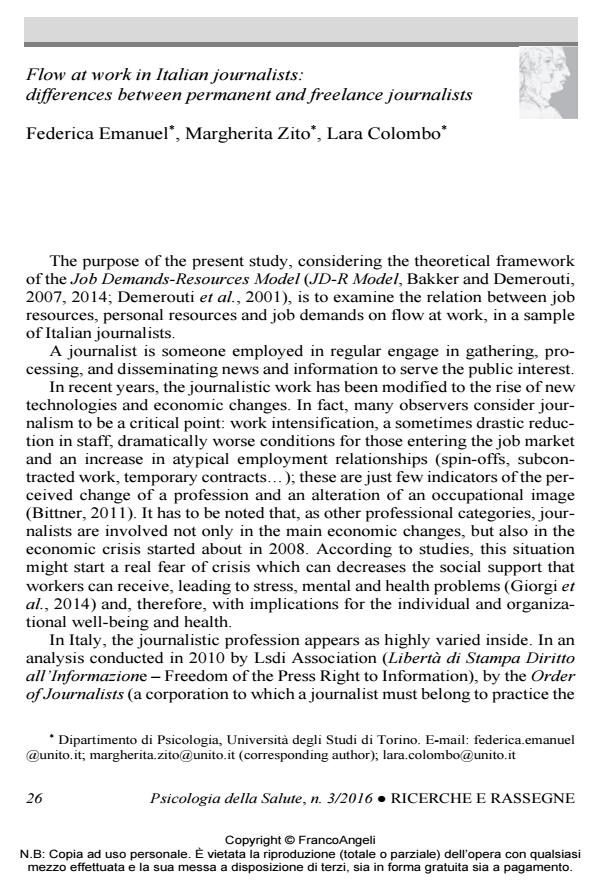Flow at work in Italian journalists: differences between permanent and freelance journalists
Titolo Rivista PSICOLOGIA DELLA SALUTE
Autori/Curatori Federica Emanuel, Margherita Zito, Lara Colombo
Anno di pubblicazione 2016 Fascicolo 2016/3
Lingua Inglese Numero pagine 21 P. 26-46 Dimensione file 223 KB
DOI 10.3280/PDS2016-003002
Il DOI è il codice a barre della proprietà intellettuale: per saperne di più
clicca qui
Qui sotto puoi vedere in anteprima la prima pagina di questo articolo.
Se questo articolo ti interessa, lo puoi acquistare (e scaricare in formato pdf) seguendo le facili indicazioni per acquistare il download credit. Acquista Download Credits per scaricare questo Articolo in formato PDF

FrancoAngeli è membro della Publishers International Linking Association, Inc (PILA)associazione indipendente e non profit per facilitare (attraverso i servizi tecnologici implementati da CrossRef.org) l’accesso degli studiosi ai contenuti digitali nelle pubblicazioni professionali e scientifiche
Flow is an inner experience produced by the participation in an activity in which people are immersed and enjoy it (Csikszentmihalyi, 1990). According to the Job Demands-Resources Model (Bakker and Demerouti, 2014), flow at work (FaW) occurs when job demands meet professional skills and when they are balanced by resources (Csikszentmihalyi, 2003). This study aimed to detect the relation between job resources (supervisors’ support, job autonomy), personal resources (optimism, internal locus of control) and job demands (workload, emotional dissonance) on FaW, in a sample of Italian journalists, considering differences between permanent and freelance. Participants are 260 journalists (118 permanent, 142 freelance) that filled out a self-report questionnaire. Data analysis (SPSS22) involved: descriptive statistics, Alpha reliabilities; correlations (Pearson’s r); t-test for independent samples; multiple regression. Results show differences between journalists: in permanent journalists FaW is influenced only by both job resources, in freelance journalists FaW is influenced by internal locus of control, job autonomy and workload. These results suggest a possible challenges-skills balance and a moderating effect of autonomy between workload and flow at work, to verify in the future. This study shows the importance to detect and to promote FaW in the same professional group, considering different types of task and employment contract. Promoting a positive organizational culture and FaW experiences is functional to prevent the risk of exhaustion, to improve performance and to protect the employees’ health and quality of working life.
Parole chiave:Flow at work, journalists, job demands-resources model, quality of working life
- All at once? The effects of multitasking behavior on flow and subjective performance Corinna Peifer, Gina Zipp, in European Journal of Work and Organizational Psychology /2019 pp.682
DOI: 10.1080/1359432X.2019.1647168 - A Scoping Review of Flow Research Corinna Peifer, Gina Wolters, László Harmat, Jean Heutte, Jasmine Tan, Teresa Freire, Dionísia Tavares, Carla Fonte, Frans Orsted Andersen, Jef van den Hout, Milija Šimleša, Linda Pola, Lucia Ceja, Stefano Triberti, in Frontiers in Psychology 815665/2022
DOI: 10.3389/fpsyg.2022.815665 - The Impact of Optimism and Internal Locus of Control on Workers’ Well-Being, A Multi-Group Model Analysis before and during the COVID-19 Pandemic Valeria Micheletto, Margherita Zito, Massimo Bustreo, Giorgio Gabrielli, Riccardo Circi, Vincenzo Russo, in Social Sciences /2022 pp.559
DOI: 10.3390/socsci11120559 - Advances in Flow Research Corinna Peifer, Gina Wolters, pp.287 (ISBN:978-3-030-53467-7)
- Passion and Flow at Work for the Reduction of Exhaustion at Work in Nursing Staff Margherita Zito, Federica Emanuel, Lara Bertola, Vincenzo Russo, Lara Colombo, in Sage Open 21582440221095009/2022
DOI: 10.1177/21582440221095009 - New Technologies Smart, or Harm Work-Family Boundaries Management? Gender Differences in Conflict and Enrichment Using the JD-R Theory Chiara Ghislieri, Federica Emanuel, Monica Molino, Claudio G. Cortese, Lara Colombo, in Frontiers in Psychology 1070/2017
DOI: 10.3389/fpsyg.2017.01070 - Engineering Psychology and Cognitive Ergonomics. Mental Workload, Human Physiology, and Human Energy Corinna Peifer, Annette Kluge, Nikol Rummel, Dorothea Kolossa, pp.204 (ISBN:978-3-030-49043-0)
Federica Emanuel, Margherita Zito, Lara Colombo, Flow at work in Italian journalists: differences between permanent and freelance journalists in "PSICOLOGIA DELLA SALUTE" 3/2016, pp 26-46, DOI: 10.3280/PDS2016-003002